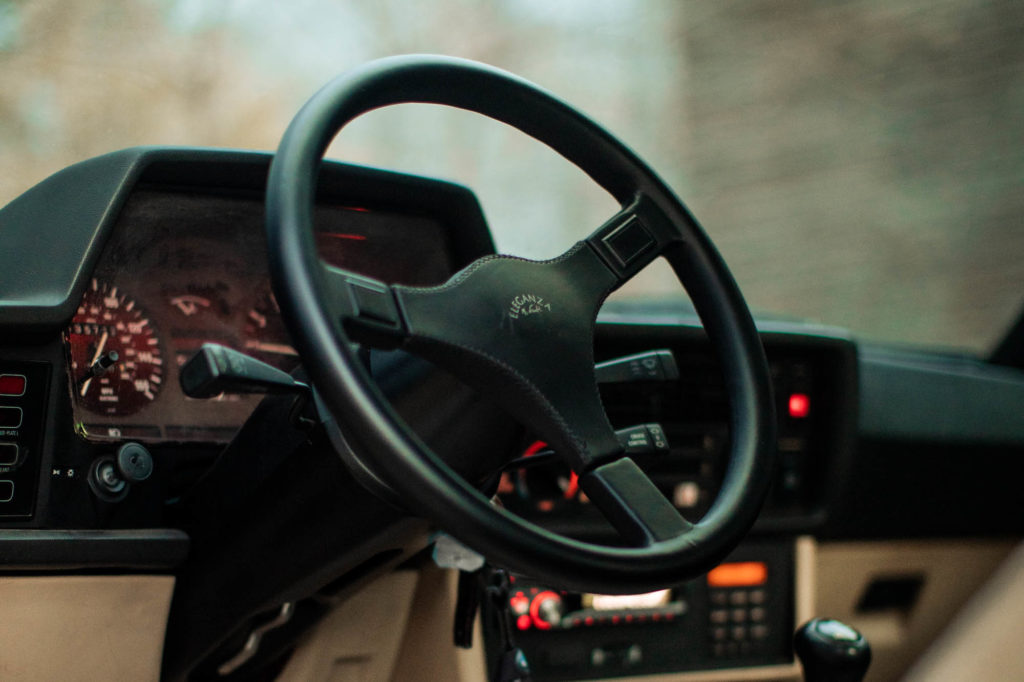The seas of high-dollar upholstery, glass, and metal that make up a vehicle’s interior look beautiful in press photos, and they might get you to visit a dealer. But it’s very often the touch points that get you out of the showroom and back into your driveway. They’re also one of the most cost-effective ways a manufacturer can cater to the driver; vast swathes of leather, aluminum accents, and ambient mood lighting are all expensive to build and customize, but adding a more supple leather to the steering wheel, a slight weight and quality material for the shifter, and some aluminum to the volume knob are easier ways to move the interior upmarket.
But as anyone who’s perused Craigslist for more than five minutes knows, luxury goods have a tendency to wear out faster under heavy use. What your Italian leather driving shoes offer in style at a Sunday-morning Cars & Coffee quickly becomes a detriment after a few too many rainy mornings.

Here’s the patient: my 1986 BMW 635CSi.
When we look for used cars, a sun-baked or deteriorated interior can make an otherwise promising candidate a non-starter. True, the condition of an interior is often a harbinger of its maintenance history and general use, but even in otherwise-clean luxury cars, exposure to sun and skin oil can take their toll on once-supple surfaces.
Thankfully, we can turn to the same tricks as the OEMs when it comes to sprucing up an aging interior: touch points. While you might get sticker shock from some of these items at first, forgoing an expensive dashboard replacement or seat recovering and focusing on surfaces where you put your hands can offer a great bang for your buck. This is something I did with my BMW 635CSi last summer, and something I now wish I’d done with many of my older cars.
My 6 Series was a factory sport-package car from 1986, and while this means it got the best of the North American options in the way of bolstered BMW sport seats and an M-Tech steering wheel, it also featured materials that wore out quickly in the warm climates that preserved its vintage metal.
This is my old M-Tech wheel. It’s not excellent.
I’ve owned this particular car for about seven years, and while I spent plenty of money and time (maybe too much) addressing the mechanical components, I hadn’t given much thought to the interior, which baked in the hot southern sun prior to my ownership in temperate Vermont. It has the usual E24 wear, in the form of a cracked dash and a slight fading of the rear carpet, but years of sweat and heat took their toll on the steering wheel. For years I’d put up with the dry, shrunken leather you see above. But when I replaced the plastic shifter with a soft leather unit from the 1990s, the discrepancy became painfully obvious.
A good M-Tech wheel, either original or recovered, will run you a steep price on eBay—about $450 and climbing—and while recovering it is cheaper (around $150), it’s inconvenient to operate a car without a steering wheel, especially without a timeline for its return.
Here’s what that wheel is supposed to look like, as demonstrated by my other M-Tech wheel (it’s a long story).
Enter the addictive world of aftermarket vintage steering wheels.
After following a few wheel collectors on Instagram, I decided to take a different direction. If I planned on recovering my factory wheel eventually, why not try something new for a bit? One such Instagram page turned out to be @Patina.Handle, run by a highly knowledgeable steering-wheel collector and seller (and fellow E24 driver) just over the Canadian border in Montreal, Quebec. After watching a few come and go, I decided to take the leap and went with a 365-mm Nardi Eleganza.
When you think of Nardi wheels, you probably think of the large, gorgeous, polished-wood wheels with twin metal spokes that you might see in an E9 or a 2002. And while those wheels are beautiful, I wanted something that was a little in the ’80s and ’90s spirit of my car.
The Eleganza looks remarkably like another Italian wheel, the Italvolanti Formel, with rectangular horn buttons and a padded center cover, although I liked the fact that I hadn’t seen very many of the Nardi model come up for sale. After some help from the seller selecting the right adapter for my facelifted “fine-spline” E24, I was ready for the installation.
There’s an immense satisfaction in installing upgrades, rather than replacement parts, to your car all by yourself, especially those projects you can do in your driveway on a long summer evening. A steering wheel is a perfect example, giving you the chance to sit in the sport seats and fiddle with Allen bolts and adapters while the breeze washes over you—and when it comes to immediate upgrade rewards, nothing quite matches the feeling of wrapping your hands around a new steering wheel.
Much better.
Going from ancient, cracked leather to this cared-for (and possibly recovered) wheel was a joy. In an instant I forgot about the cracked dash and the tired floormats, and the handful of missing switch covers. The phrase is played out, but the old E24 felt like an entirely different car.
Like a nice mattress, or new cabinet handles, there’s a deep satisfaction that comes from upgrading something you use every day. Whether you choose to recover your wheel or track down a period-correct aftermarket replacement, putting fresh leather under your fingertips is transformative for a car or an interior that’s seen many years of use.
Will I switch back to the stock wheel, though? As it happens, I recently found myself in possession of that elusive second M-Tech E24 steering wheel—this time, in absolutely perfect shape. But after some consideration, I’ve decided to hold off on installing it, at least for now. Who knows? Maybe after another ten or fifteen years of heat cycles, spirited mountain drives, and white-knuckle corners, I’ll get to feel the satisfaction of a fresh steering wheel all over again.—David Rose
[Photos courtesy David Rose.]
